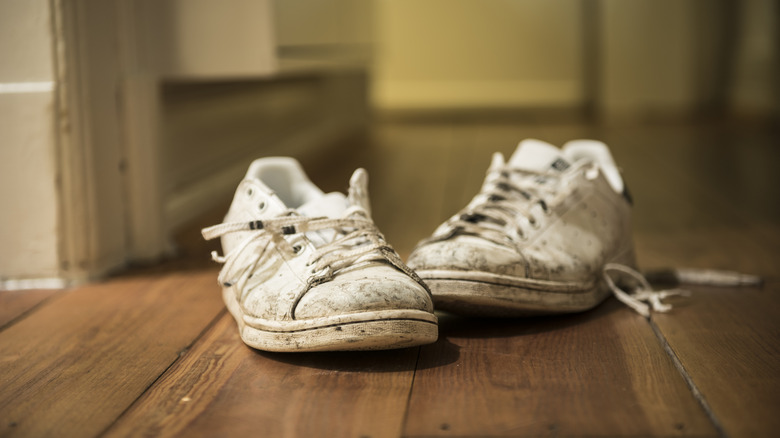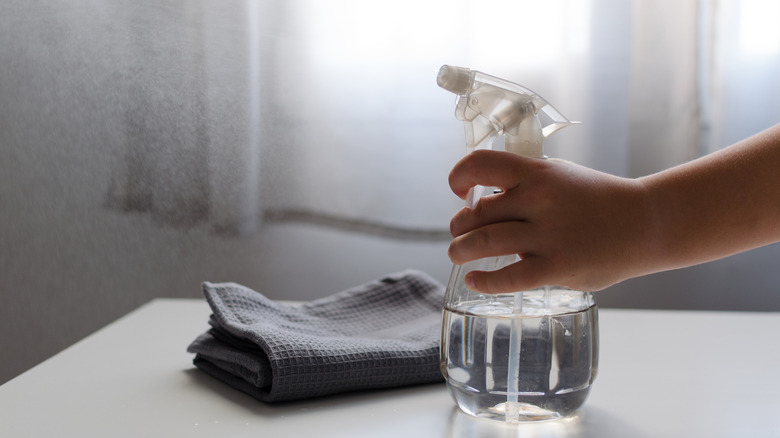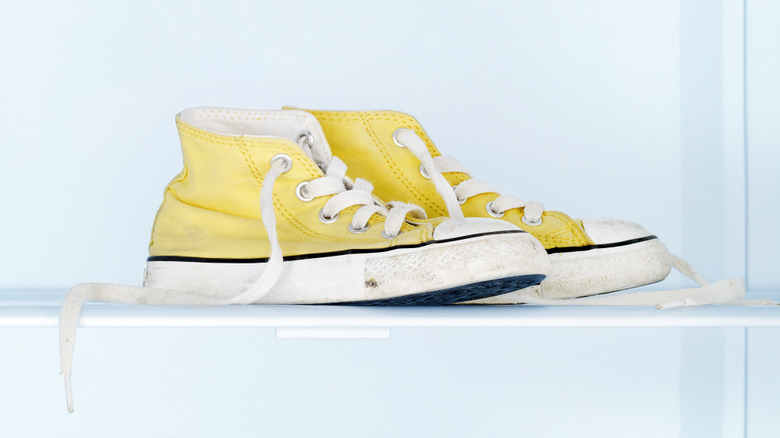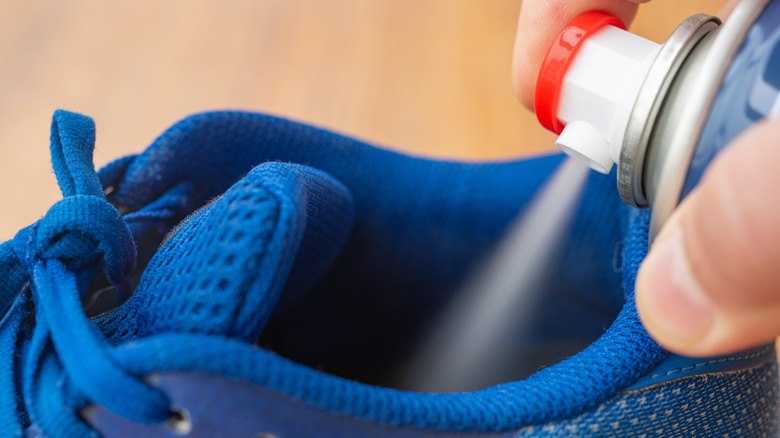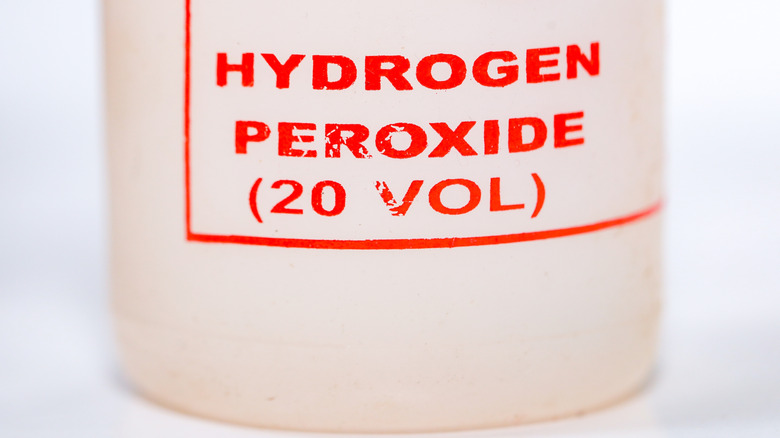12 Ways To Clean And Deodorize Stinky Shoes That Shouldn't Be A Secret
We may receive a commission on purchases made from links.
We've all been there: you slip off your sneakers after a long day, and suddenly, an unwelcome funk fills the room. While it can be quite unsettling for your partner or kids, it can also be quite embarrassing if you're visiting a friend's home who has a no-shoe policy. Shoe odor has a way of creeping into your favorite kicks and making its presence known, whether you like it or not.
It's far more common than you may think, and it's completely natural for your prized pair to develop a whiff that may cause the dog to get up and walk out of the room. It builds up when sweat, bacteria, and a dash of everyday grime settle into the dark corners of your shoes, where fresh air rarely ventures.
While you may be tempted to toss them into the bin, the good news is that there are a few simple hacks that can revive your shoes to their former fresh glory. It isn't just about masking odors with sprays or sticking your sneakers out in the sun — with a few shoe cleaning hacks that tackle the science behind what's really causing your shoes to smell, the problem can be solved. From baking soda and essential oils to steam and cornstarch, here's what you need to know about removing bad shoe odor.
Use baking soda: Natural odor neutralizer for shoes
If you're after a tried-and-true hack for smelly shoes, baking soda may just be your new best friend. The thing about baking soda is that it's great at neutralizing acid-based odors in water, and it adsorbs odors from the surrounding air. This is one of the reasons why it's used as a common home cleaning hack for a variety of chores. For shoes specifically, the magic lies in its more scientific name — sodium bicarbonate, which is a mild alkaline that neutralizes acids and produces carbon dioxide gas through chemical reaction. Let's not get too technical, though — all you need to know is that it works.
The bacteria that build up in your shoes mix with sweat and create an acidic byproduct. This is what smells so bad. What the baking soda does is bring the acidic odor molecules into a more neutral state, which gets rid of the smell. So, you're not masking the smell but rather eliminating it. To use baking soda to remove shoe odor, simply sprinkle it directly onto your shoes, making sure to cover your entire insole. Shake the shoe around a bit to make sure the baking soda is distributed, and then leave it for 24 hours. Then, shake your shoes off upside down over the bin, and you'll be good to go.
White vinegar spray: Odor buster for shoes and feet
While white vinegar may add a tang to your fries, it can also work wonders on the smell emanating from your favorite pair of kicks. How does white vinegar remove odor from shoes, though? As with baking soda, vinegar is naturally acidic, which creates havoc for the bacteria that thrive in the dark and damp spaces within your shoes. It's essentially a diluted solution of acetic acid, the compound that makes up around 4% to 7% of vinegar. As vinegar is a mycobactericidal disinfectant, it can help kill the bacteria that cause that awful stink.
To freshen your shoes with vinegar, take a spray bottle and mix equal parts white vinegar and water. Then, take your shoes outside and spray them both inside and out, making sure you get right into the deep and dark areas. Next, place the shoes in direct sunlight and let them dry. The sun will help to remove all the excess moisture in the pair. The great thing about vinegar is that you can use it on your feet as well, so combine two parts water with one part vinegar and soak them in a bowl for 15 to 20 minutes. This will help to keep bacteria at bay.
Essential oils: Freshen up those kicks
If you're caught off guard by shoe odor and have essential oils on hand, they can offer a quick and relatively simple short-term fix. Essential oils like tea tree, lavender, eucalyptus, and peppermint are known for their antibacterial and antifungal properties, making them a great natural option for fighting mild shoe odors. This is, however, a key caveat: while a few drops of oil on a cotton ball or tissue stuck into the shoe overnight can freshen things up, this method won't eliminate the bacteria deep within the insole or fabric. The refreshing scent will mask the odor temporarily, and in some cases, provide a mild reduction in bacteria and fungus, but it won't tackle the root of a stubborn smell. Still, it's a good option to place these essential oil-soaked cotton balls in your shoes if you're in a rush and don't have time for a more thorough deep clean.
Another way to use essential oils to remove shoe smells is to make a diluted spray from essential oils mixed with water. Mist the inside of your shoes lightly — but be cautious and use it sparingly, since pure oils can stain some materials and leave telltale marks, especially on light fabrics or suede. We'd suggest using it on an inconspicuous spot first. Remember, essential oils work best as a "top-up" between deep cleans rather than as your only solution. You can also use these oils directly on your feet.
Charcoal insoles: Odor absorbing shoe inserts
Sometimes, a simple switch inside your shoes can work wonders for lingering odors, and that's where charcoal insoles come in handy. Charcoal, especially in its activated form, boasts an ultra-porous structure that traps odor molecules and soaks up excess moisture, creating a less friendly environment for odor-causing bacteria. NASA even gave activated carbon cloth its stamp of approval (originally researching it for use in spacecraft air filtration), and this same high-tech approach is what you'll find behind innovative inserts like Zorpads and other big insole brands. The insert method is fairly straightforward: simply slip a pair of charcoal insoles or deodorizer bags into your shoes and let them absorb for up to 48 hours.
You don't have to take NASA's word for it — mainstream products like Odor-Eaters and Dr. Scholl's shoe inserts use super-activated charcoal alongside other ingredients to fight odor and wetness throughout the day. You don't only have to look for the insole brands — you can also find activated charcoal sachets and place these in your shoes to achieve the same result. It's all about the way the charcoal works, instead of the structure of the item you place inside your shoes. While charcoal insoles are not always a cure-all, they're an easy, low-maintenance solution that works around the clock to keep shoes fresher for longer.
Freezing method: A quick way to hit pause on odor-causing bacteria
If you need a fast, low-effort fix for smelly shoes, popping them in the freezer can help — just not in the way many people think. While freezing temperatures don't reliably kill bacteria, they can weaken them, slow down their activity, or send them into a dormant state. Since bacteria thrive in warm, moist environments, the sudden shift to freezing cold disrupts their ability to multiply and produce those pungent odor molecules. Think of it as pressing pause rather than hitting delete. This makes freezing a handy option when you need your shoes to smell fresher quickly, especially if you're heading out the door soon and don't have time for a deep clean. It's also one of the few methods that works without sprays, powders, or liquid solutions, and is ideal for delicate materials that you don't want to risk staining.
To put a stop to shoe smell by freezing them, place the pair in an airtight plastic bag to prevent moisture transfer and protect them from picking up food smells. Leave them in the freezer overnight or for at least twelve hours. When you take them out the next morning, allow them to warm up naturally and fully dry before wearing them again. The odor should be noticeably reduced, but keep in mind that this method doesn't tackle the bacteria long-term.
Use steam: Blast away the microbes
If you're looking for a powerful way to freshen up smelly shoes without harsh chemicals, steam is one of the most effective tools you can use. Steam works because high heat disrupts the structure of many bacteria and fungi, basically denaturing the proteins they rely on to survive. While not all microbes are destroyed instantly, many common odor-causing strains struggle to withstand temperatures above 149°F (around 65°C).
Since steam can reach these temperatures easily, it offers a science-backed way to reduce the microbial load inside your shoes. This makes it really useful if your shoes smell because of trapped sweat or if you've been wearing them without socks. A great benefit of steam is that it penetrates deeper into materials than surface sprays, loosening grime and build up that could be feeding the smell.
To steam blast the bacteria in your shoes, you can use a handheld steamer, a garment steamer, or the steam burst function on your iron — just be sure to keep the iron itself from touching delicate fabrics. Hold the steam source a few inches away from the inside of your shoes and give each area a slow, thorough pass. Focus on the insole, toe box, and any padded areas, since these tend to trap the most moisture and bacteria. After you've given them a good steam, place the shoes in a warm, well-ventilated spot and let them dry completely.
Spray disinfectants or rubbing alcohol to kill off odor-causing bacteria
Disinfectant sprays and rubbing alcohol can offer a fast, effective way to target the bacteria at the root of your smelly problem. Most commercial disinfectant sprays contain ingredients specifically designed to break down the cell walls of bacteria and fungi, making them a great option when you need your shoes to smell fresher quickly. No smelly cells means no smelly shoes.
Rubbing alcohol, on the other hand, usually contains 70% isopropyl alcohol, which works similarly: it evaporates quickly, dries out moisture-loving microbes, and disrupts their ability to survive. Because bacteria thrive in damp, enclosed spaces, applying disinfectant or rubbing alcohol directly to the inside of your shoes gives them far less room to multiply.
To use a disinfectant spray, lightly mist the inside of your shoes, paying special attention to the heel, toe box, and insole. Avoid saturating the pair, as excess moisture can create new issues. With rubbing alcohol, you can either spray a diluted solution or apply it using a clean cloth. Once applied, allow the shoes to dry completely in a well-ventilated area. For particularly stubborn odors, you can repeat the process every few days or combine it with another deodorizing method like baking soda or charcoal inserts.
Use deodorizers and odor removers
If your shoes have reached the point where home remedies just aren't cutting it, you may need to go the commercial route and head to your local supermarket or pharmacy. Look for a reputable shoe deodorizer or odor remover for a stronger, more targeted solution. These products are specifically formulated to neutralize the stubborn compounds that cause shoe odor, often using a combination of antimicrobial agents, moisture absorbers, and freshening scents.
Many popular options rely on ingredients like zinc oxide, essential oil blends, or enzymatic cleaners that break down the organic matter bacteria feed on. If you look hard enough, you'll find brands with more advanced ingredients, like cyclodextrins, which are ring-shaped molecules that trap and lock in odor particles. Because these products are designed for footwear, they tend to offer a deeper and more effective solution to smelly shoes.
Using a shoe deodorizer is fairly straightforward: most come as a spray, powder, or small insert. For sprays, apply a light, even mist to the inside of your shoes and let them dry completely before wearing. Powders can be sprinkled directly onto the insole, where they work throughout the day to absorb moisture and odor. Insert-style deodorizers — like small pods, sachets, or pellets — can be left inside overnight to refresh your shoes between wears. While deodorizers work well on their own, they're even more effective when combined with some of the methods we already mentioned, like using rubbing alcohol or steaming.
Use foot powders or cornstarch: Keep feet dry and odor-free
This one is more about prevention than cure. When it comes to avoiding a situation of smelly shoes in the first place, moisture control is half the battle. One way to tackle this issue is to make use of foot powders or cornstarch. As bacteria and fungi thrive in moist, warm environments, if you remove the moisture, you minimize the chances of these two contributors to smelly shoes spreading. Most foot powders combine ingredients like talc, zinc oxide, or baking soda to absorb sweat and neutralize odor-causing acids on contact.
While you may already use cornstarch in your laundry, it's great for feet as well. It works in a similar way to foot powders, acting as a natural moisture absorber that pulls dampness away from your skin and, by extension, your shoes. It's an especially useful option for people with naturally sweaty feet or those who spend long hours in closed-toe shoes. By reducing moisture at the source — your feet — you prevent the smell from fully settling into your insoles.
To use a foot powder, sprinkle a small amount onto clean, dry feet before putting on socks or shoes. Focus on areas that tend to sweat the most, like between your toes and around the heel. You can also shake a light layer directly into your shoes to help them stay fresher throughout the day. If you prefer a natural alternative, dust cornstarch onto your feet or apply it to the inside of your shoes overnight, then shake out any excess in the morning.
Use a laundry sanitizer on washable shoes
While not every pair of shoes can handle a spin in the washing machine, many modern styles — like washable knit sneakers, canvas slip-ons, and brands such as Rothy's — are designed specifically for it. If you're washing these shoes to combat odor, you can use your standard detergent to give them a thorough clean. Sometimes this isn't enough though, and that's where a laundry sanitizer comes in. These products are formulated to kill bacteria, fungi, and odor-causing microbes that regular detergent may leave behind. If your pair of trainers has been soaking up sweat for a while and is about as pungent as they come, then a good laundry sanitizer might do the trick.
As you might do for your gym wear or towels, it's a good idea to get into a routine of giving those running, cycling, or gym shoes a cycle with laundry sanitizer. Just be sure to check the care label and use a cold, gentle cycle to avoid damaging the various materials that make up your shoes. It's recommended that you first take out the insoles and laces and pre-treat any heavily soiled areas. Then, wash the shoes with a mild detergent plus the recommended amount of sanitizer. Once the cycle is done, avoid the dryer as the heat might cause damage. Rather, let the shoes air dry completely. For a boost of UV as a natural shoe odor repellent, place them in the sun for a while.
Leverage a mild solution of hydrogen peroxide
If you can't wash your shoes in the washer, using a mild hydrogen peroxide solution is another surprisingly effective way of dealing with your shoe stink problem. What hydrogen peroxide does, thanks to its antimicrobial properties, is break down into water and oxygen as it reacts with organic material. This helps to kill the odor-causing microbes and loosen the grime it feeds on. Provided you use it correctly, it can act as a gentle disinfectant that reaches right into the fabric of your shoes.
How do you use hydrogen peroxide without damaging your shoes, though? The key is to use a diluted 3% solution, which is strong enough to sanitize the pair without damaging most materials. Start by making sure your shoes are completely dry, as moisture can dilute the impact of the hydrogen peroxide. Then, using a spray bottle, mist inside each shoe. Don't soak them, as the excess liquid could cause discoloration. All that's left to do is then let them air dry. We recommend you first do a spot test on a small area of the shoe to check that the material is not too sensitive for the hydrogen peroxide.
Embrace technology and try a UV shoe sanitizer
If you're looking for a hands-off, tech-driven way to tackle stubborn shoe odor, a UV shoe sanitizer might be worth considering. These devices use ultraviolet-C (UVC) light — the same germicidal wavelength used in some medical and laboratory settings — to disrupt the DNA of microbes. When bacteria and fungi are exposed to UVC light, they can no longer reproduce and in most cases die off. It forms part of a great maintenance plan for anyone dealing with recurring issues like athlete's foot or long-term odor buildup. Because odor in shoes is almost always tied to microbial activity, using a UV sanitizer can help reduce the bacteria responsible for lingering smells.
While this isn't the cheapest option on the list, it's one of the few truly labor-free ways to sterilize and deodorize your shoes without sprays, powders, or washing. You simply place the devices into your shoes, switch them on, and let the light do the work. There are a few options to choose from depending on your budget, with some costing around $50 or the more costly Pedifix ShoeZap UV shoe sanitizer product, which comes in at around $150. While certainly not one of the most affordable ways to remove shoe odor, they can be effective.
